TCBで所有しているビンテージのミシンとそれらを使っての縫製に関して紹介します。
We’d like to introduce the vintage sewing machines that TCB owns and uses and the sewing techniques used on our products.
使用ミシン: Union Special 35800G 1950年代
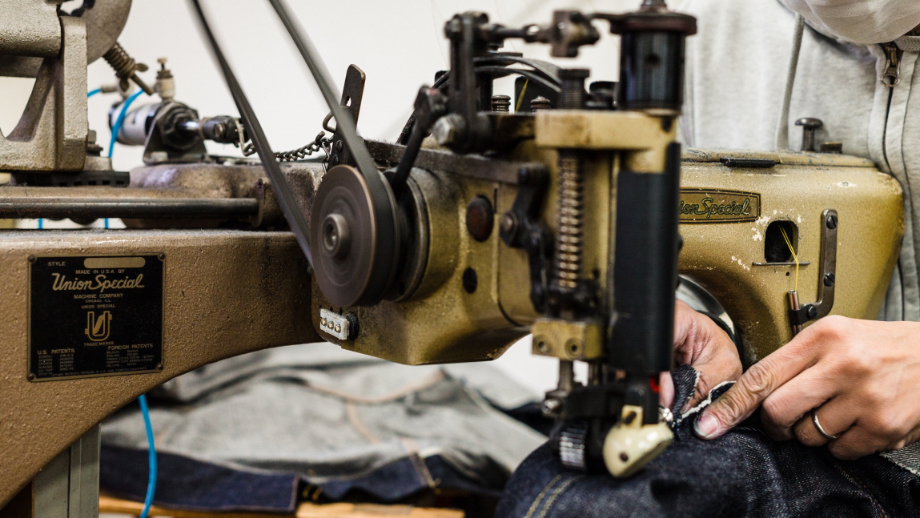
ジーンズのバックヨークや、ジャケットのアームホールなどは巻き縫いと呼ばれる生地と生地を重なり合わせて、その上から縫う巻き縫いをするミシンです。TCBでは同様のミシンを計6台所有しており、各種1/4, 9/32, 5/16inchと縫い幅に合わせてセッティングを変えています。この縫い幅ですが、mmに直せば6mm, 7mm, 8mmと1mm分の差しかありませんが、この細かな縫い幅の違いであっても、製品としてみたときの印象は大きく変わりますので、再現するビンテージの縫い幅に基づき使用するミシンを変えています。
When sewing the back yoke on jeans or armholes on jean jackets, we use Union Special 35800 from the 50’s in which two fabrics are overlapped and on top of the overlapped part the needles go in and out. TCB owns 6 of this sewing machines with each seaming width set for a different width: 1/4, 9/32, and 5/16 inches. If you put them into mm, it’s 6, 7, and 8 mm as you might find there being no big difference but when you look at the product in person, the seaming width does make a big difference. Therefore, we use the same machine with a different setting, depending on which vintage we give a birth to again in this world.
また、このミシンは”巻き縫い”という一つの縫い方専用のミシンとなります。
もともとのジーンズの生産とは、各工程別にミシンや縫い子が分かれており、できるだけ生産効率を上げるために、作業の細分化/ミシンの最適化が進んでいたため、このような特定の箇所のみを縫うミシンが開発されました。
This sewing machine is used only for the lapped seam method. Back in those days, in order to increase the production efficiency to the fullest, each production procedure used to be separated and each sewing machines got streamlined for each process. That’s why these sewing machines were developed even though they were not versatile at all.
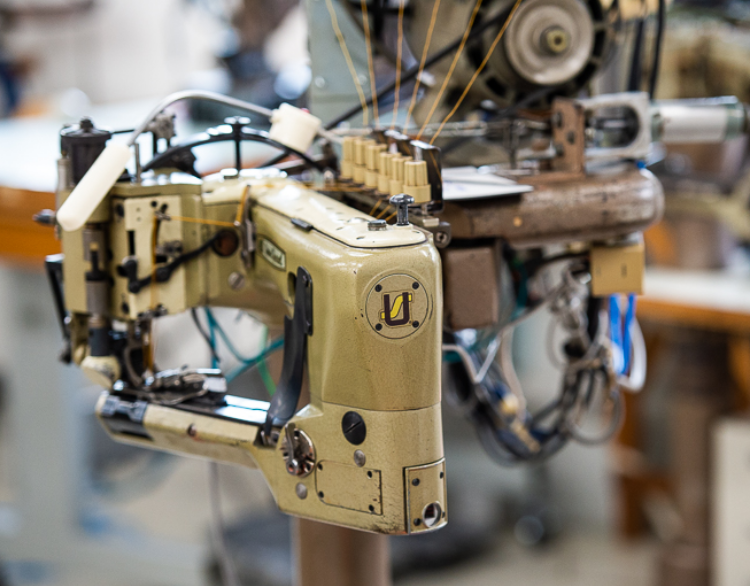
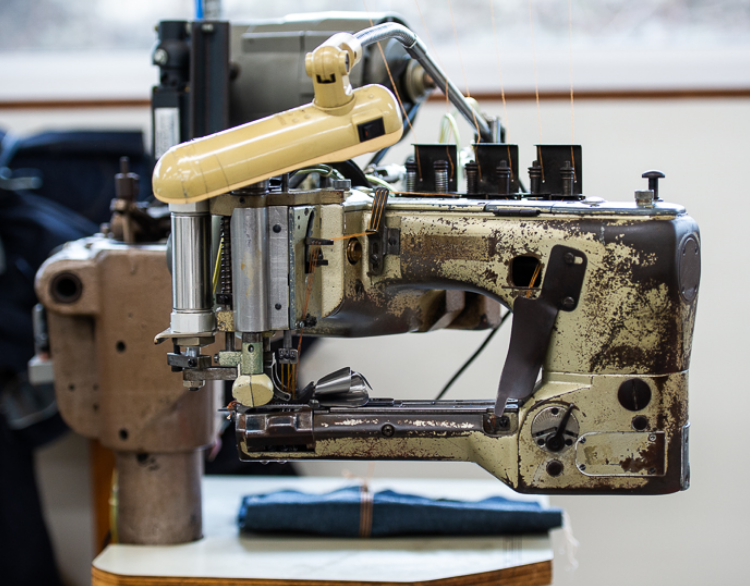
では、なぜこういったミシンで縫う必要があるのか?
Then, why do we still need to make jeans with the vintage machines?
一つは、縫う糸の違いに関係します。
こういったUnion Specialが使われていた時代の主流となった糸は綿糸でした。今日では、化学繊維の糸が使われ、その糸は細い、強い、滑りもよいと3拍子揃った糸であるため、ミシンに力を求めずとも綺麗な縫製が可能です。
ですが、TCBの製品に使われている綿糸はというと、弱いため糸を太くせざるを得ない、紡績技術も昔は未熟であったため糸ムラがあり滑りが悪い、と縫う機械側のパワーがなければ、硬く、重いジーンズの生地を綿糸で縫うことは困難でした。
ですが、製品となり洗いがかかった後の縫い目のウネリ、パッカリングは当時のミシンで、当時の糸を使って縫うからこその表情であり、それがTCBの実現したいジーンズ、強いては、作りたいものということなのです。
One of the reasons is attributed to the difference in the thread used.
When these Union Special machines were used, cotton threads are the main stream one used. Nowadays, chemical fiber yarns are definitely the major one which is so thin, durable and smooth enough for the sewing that the sewing machines don’t need any strong power. On the other hand, the cotton yarns are weak so the yarn count needs to be bigger and they are not smooth because the spinning method was not fully developed. All of those reasons led to that the sewing machines themselves needed to be powerful enough to sew the thick and hard denim fabric.
However, the unique puckering on the hems or the back yoke are brought to our jeans all thanks to the methods, the threads and the sewing machines used back in the era, which is also what TCB does want to recreate and make as a company.
使用ミシン: Union Special 51800G 1940年代
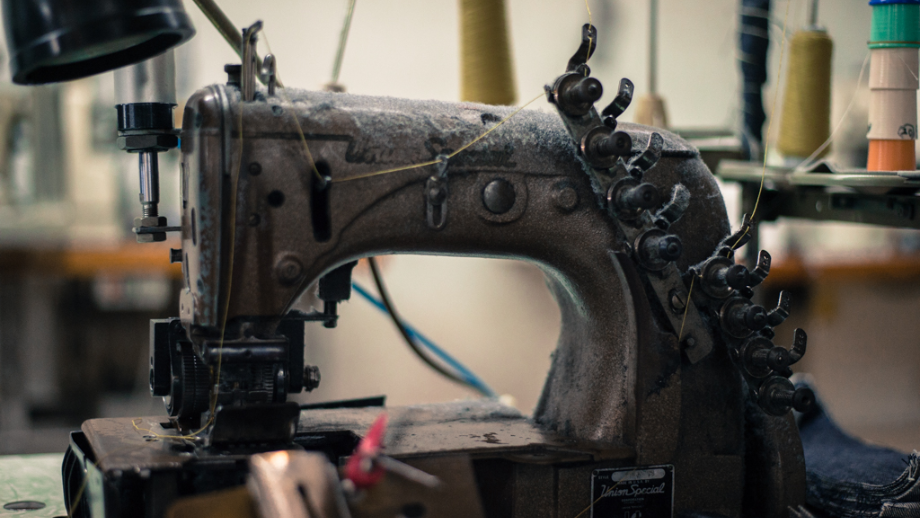
巻き縫いミシンと同じく、ジーンズの腰回りや、ジャケットの腰回りの帯を縫う専用のミシンです。
As the same principle goes for this machine, this is used only when we sew the waist belt on the jeans or the jackets.
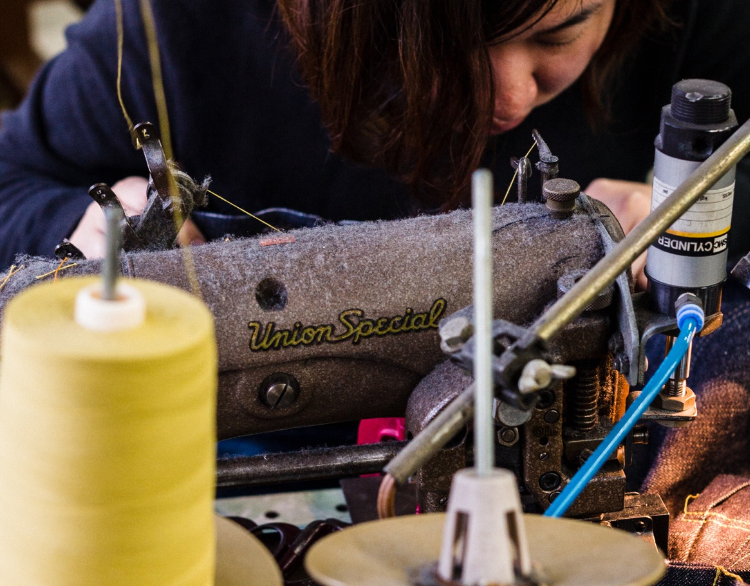
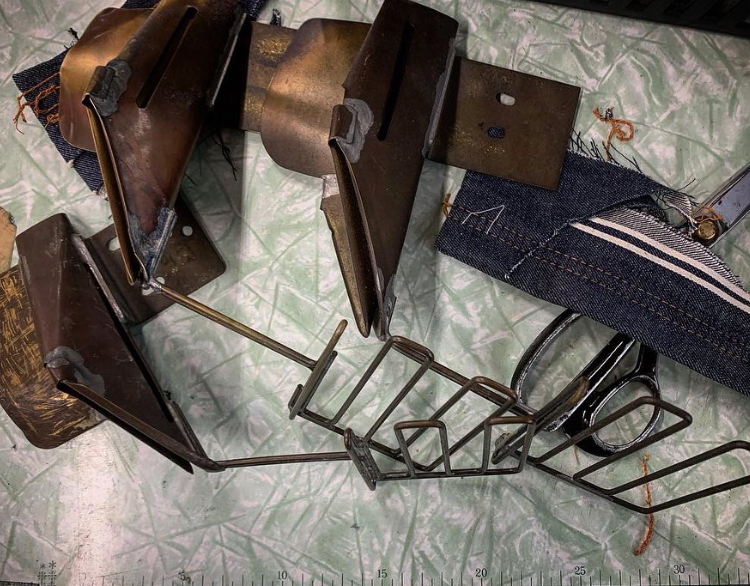
こちらもラッパと呼ばれる生地を通すガイドの役割を果たす金物で、縫う幅を調整することができます。ですので、この幅で縫いたい!となれば、このラッパを作るというところからTCBのものづくりは始まります。通常、縫い合わせる生地と生地を共にアイロンがけをして、縫いやすくするのですが、このラッパはその工程を省き、ラッパを通せばミシンが縫う場所を決めてくれるという役割を果たしており、ここにも生産効率をあげるという考えが見て取れます。また、これらのミシンで縫うと、縫いあがりが鎖のように連なった見た目になることでチェーンステッチという手法になります。このミシンは、ボビンから下糸を取る必要がないため、糸を変える頻度とその手間が減るという、またもや生産に関わる理由で生まれたものでした。
When sewing the waist belt, we use several types of the parts called “Folder” which, as the name goes, folds the fabric and enables to change the seaming width. So, when we make something new and want to sew with a certain width of the waist belt, the first thing we tackle is to make the folder part specifically for the product. Before these Union Special appeared, the producers needed to iron the fabric first to make the fabrics flat but these machines lifted off of the task and did the work instead of human so it was such a breakthrough in the history of sewing machines. With these machines, the finish look of the bobbin thread resembles the chain so that the sewing method is called chain-stitch. This also helps the production efficiency in a way that the sewing machines can take the threads directly from a spool, meaning that there is less frequency to change the spools amid the production.
使用ミシン: Union Special 43200G 1940年代
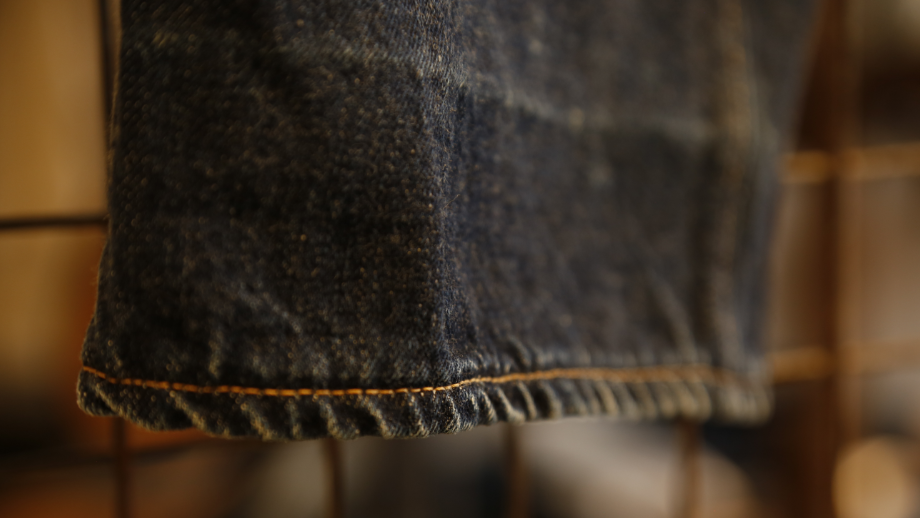
こちらも帯付ミシンと同じく、生地をラッパに通すことで、裾の折り込みをミシンがやってくれるが故、アイロンがけを無くして、裾部分を縫うことが可能です。ですが、ミシンが折ってくれるからこそ、写真のように裾縫いが捻れて仕上がります。だからこそ、裾のウネリを生むのですが、1960年代以降ジーンズは作業着からファッションアイテムと変化していく中で、そのウネリが”仕上がりが汚いもの”と認識されだすことから、このUnion Specialというミシンから、日本で言えば、Kansai Specialなど新たなミシンが生産の表舞台に立っていくことになりました。
This sewing machine can fold the hem like the 51800G can do it so that there is no need ironing the fabric before the hemming. But, it makes the undulation on the hems like the picture above because the sewing machines do fold the fabric for you.
After 60’s when the jeans started to be recognized as a fashion item, not as workwear, the waving looking on the hems started being perceived as not cleanly finished. It put a period to the kingdom of Union Special in a sense, other sewing machine brand such as Kansai Specials rising its head in the blue-ocean market.


今や、裾上げはUnionでないと!といった声もよく聞くようになりましたが、時代によって評価されるものが違う、変わるということは面白くもありますね。
Now that we often hear some say that the best hemming machine is definitely the Unions but it sure is interesting how the recognition towards one thing can change, depending on the time.
Union Specialの裾縫いミシンがなぜパッカリングを生むのか?
通常、ミシン針は生地に対して垂直に降りていきますが、このミシンは針が斜めに入っていきます。よって、仕上がりも斜めに若干ずれ込み、生地のズレからパッカリングが生まれるという仕組みです。
Why Union Specials can bring the beautiful puckering?
Normally, the needle drops down perpendicularly to fabric but when it comes to Union Specials, the needle goes down with some angles, ending up making a slight distortion on the hem, which leads to the puckering in the end.
使用ミシン: REECE104
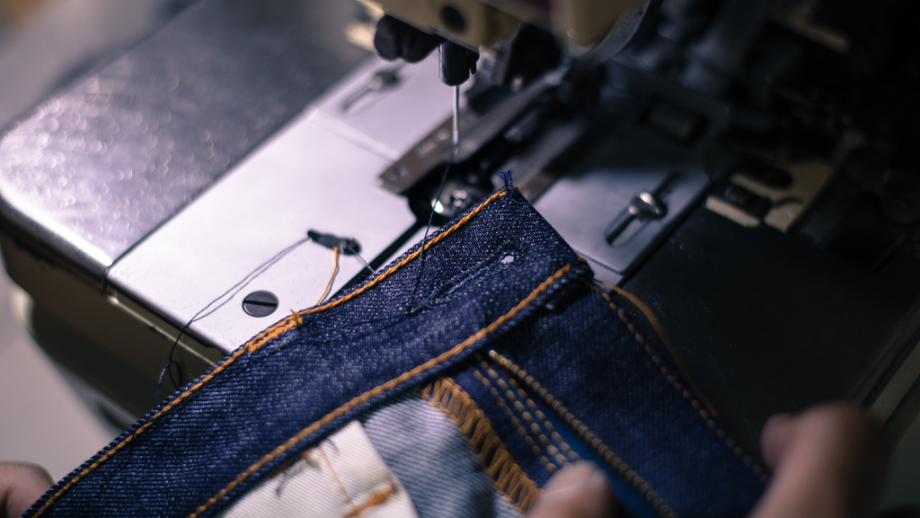
TCBでは、ボタンホールは”後メス”という手法で縫われています。
現在主流の先メスから説明するとボタンホールの穴を開けた後に、回りを補強していくのが前メス。その逆が”後メス”という手法です。
For all the button holes for TCB products, we first do the buttonhole stitch and then open the hole, which is not the main stream way to make the button holes.
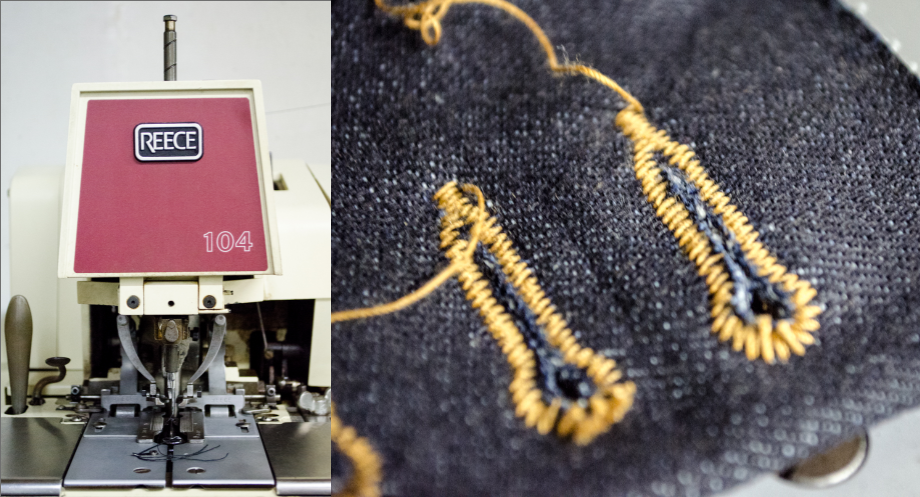
もちろん、前メスであれば空いている穴に対して、その縁を綺麗に縫っていけるわけですから、ボタンホールの仕上がりは綺麗です。後メスの場合、縫ってから穴を開けるわけですから、どうしても縫い縁とボタン穴の間に若干の生地の余りが生まれてしまいます。では、なぜ後メスにするのか?それは、先ほどの綿糸で縫うという部分に関係し、実はビンテージは基本的に後メスで仕上げられています。
In the normal way, first the hole is made and then the stitches are applied so the finish look will be cleaner whereas in the other way, there is some fabric hanging inside a buttonhole which some people might describe roughly-made. Then the question is why TCB adopts the less clean method. In actuality, this related to the fact that TCB uses the cotton threads for all the sewing.
これにはTCBの解釈も含まれますが、綿糸=弱いです。そして、前メスで仕上げるとボタンホール縁ギリギリにボタンがきますから、ボタンと補強縫いが直接触れる機会が多くなります。結果、補強縫いがすぐに取れてしまうということです。一方、後メスの場合、ボタンが直接触れ合うのは生地の余り部分ということで、仕上がりは粗野に見えますが、丈夫で長持ちするワークウェアとしての本望を全うできる仕上がりをTCBでは採用している訳です。
As mentioned above, cotton threads are less durable. If you finish the button hole in the hole-first method, the button hole reinforcement will often have contacts directly with the buttons, which will easily cause a fray. However, with the hole-later method, there is some fabric hanging from the fringe of the buttonhole that functions as the cushioning.
Therefore, most of the vintage work wears are made with the hole-later method as the best effort made to fulfill the duty as workwear